Cholera in India: Disease Dynamics and Public Health Research Report
VerifiedAdded on 2022/09/14
|10
|4086
|10
Report
AI Summary
This research report provides a detailed analysis of cholera in India, starting with its microbial origins from the bacterium Vibrio cholerae and its transmission through the fecal-oral route, often linked to poor sanitation and contaminated water. The report describes the mechanism of action of the cholera toxin, the symptoms of the disease, and the diagnostic, treatment, and prevention methods. It also delves into the historical context of cholera epidemics in India, tracing the first six pandemics and their spread across the globe, particularly highlighting the first Asiatic cholera pandemic and its impact on the Indian subcontinent and beyond. The report emphasizes the importance of hygiene, sanitation, and vaccination in controlling the disease and concludes with a discussion of the WHO's Global Roadmap to End Cholera by 2030.
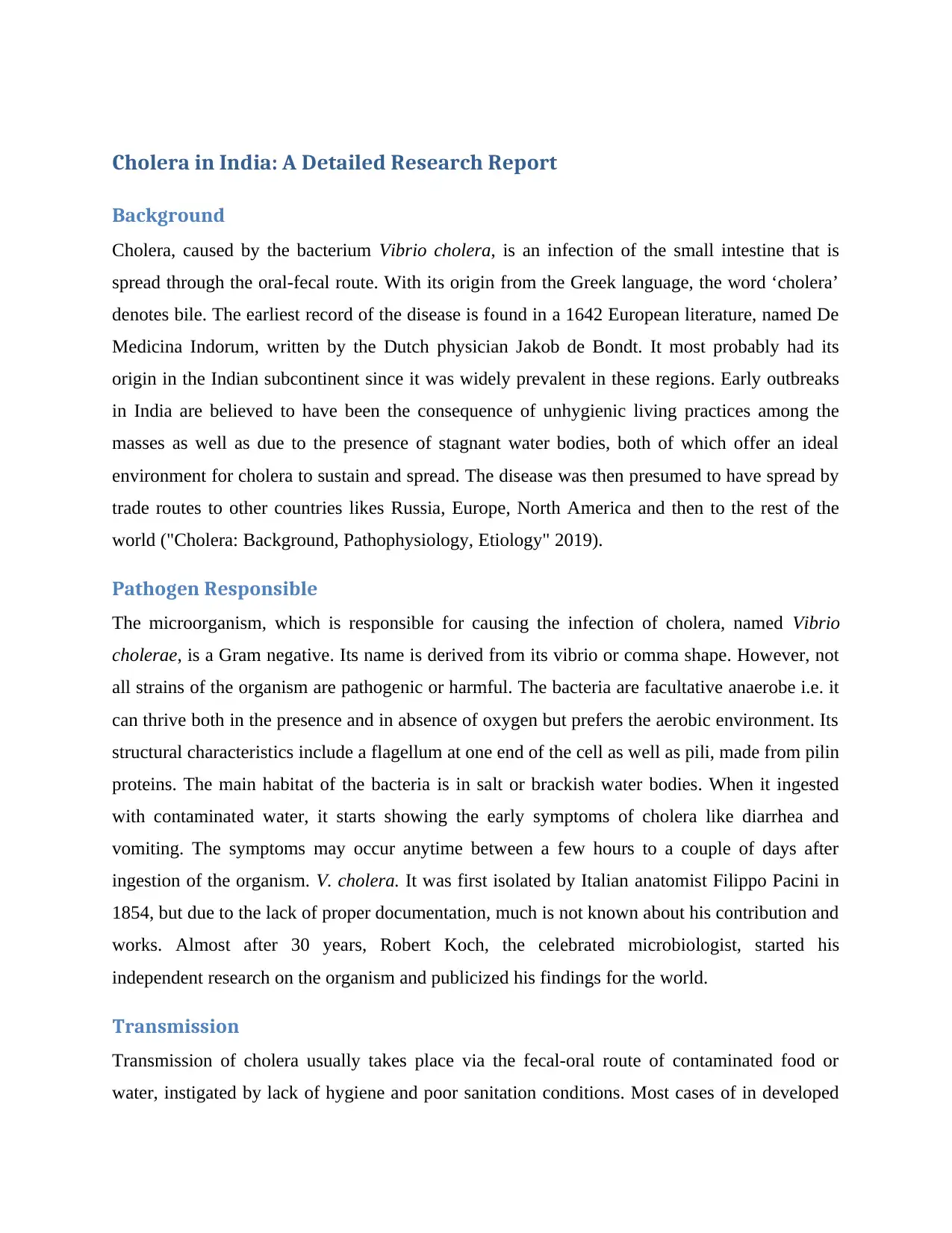
Cholera in India: A Detailed Research Report
Background
Cholera, caused by the bacterium Vibrio cholera, is an infection of the small intestine that is
spread through the oral-fecal route. With its origin from the Greek language, the word ‘cholera’
denotes bile. The earliest record of the disease is found in a 1642 European literature, named De
Medicina Indorum, written by the Dutch physician Jakob de Bondt. It most probably had its
origin in the Indian subcontinent since it was widely prevalent in these regions. Early outbreaks
in India are believed to have been the consequence of unhygienic living practices among the
masses as well as due to the presence of stagnant water bodies, both of which offer an ideal
environment for cholera to sustain and spread. The disease was then presumed to have spread by
trade routes to other countries likes Russia, Europe, North America and then to the rest of the
world ("Cholera: Background, Pathophysiology, Etiology" 2019).
Pathogen Responsible
The microorganism, which is responsible for causing the infection of cholera, named Vibrio
cholerae, is a Gram negative. Its name is derived from its vibrio or comma shape. However, not
all strains of the organism are pathogenic or harmful. The bacteria are facultative anaerobe i.e. it
can thrive both in the presence and in absence of oxygen but prefers the aerobic environment. Its
structural characteristics include a flagellum at one end of the cell as well as pili, made from pilin
proteins. The main habitat of the bacteria is in salt or brackish water bodies. When it ingested
with contaminated water, it starts showing the early symptoms of cholera like diarrhea and
vomiting. The symptoms may occur anytime between a few hours to a couple of days after
ingestion of the organism. V. cholera. It was first isolated by Italian anatomist Filippo Pacini in
1854, but due to the lack of proper documentation, much is not known about his contribution and
works. Almost after 30 years, Robert Koch, the celebrated microbiologist, started his
independent research on the organism and publicized his findings for the world.
Transmission
Transmission of cholera usually takes place via the fecal-oral route of contaminated food or
water, instigated by lack of hygiene and poor sanitation conditions. Most cases of in developed
Background
Cholera, caused by the bacterium Vibrio cholera, is an infection of the small intestine that is
spread through the oral-fecal route. With its origin from the Greek language, the word ‘cholera’
denotes bile. The earliest record of the disease is found in a 1642 European literature, named De
Medicina Indorum, written by the Dutch physician Jakob de Bondt. It most probably had its
origin in the Indian subcontinent since it was widely prevalent in these regions. Early outbreaks
in India are believed to have been the consequence of unhygienic living practices among the
masses as well as due to the presence of stagnant water bodies, both of which offer an ideal
environment for cholera to sustain and spread. The disease was then presumed to have spread by
trade routes to other countries likes Russia, Europe, North America and then to the rest of the
world ("Cholera: Background, Pathophysiology, Etiology" 2019).
Pathogen Responsible
The microorganism, which is responsible for causing the infection of cholera, named Vibrio
cholerae, is a Gram negative. Its name is derived from its vibrio or comma shape. However, not
all strains of the organism are pathogenic or harmful. The bacteria are facultative anaerobe i.e. it
can thrive both in the presence and in absence of oxygen but prefers the aerobic environment. Its
structural characteristics include a flagellum at one end of the cell as well as pili, made from pilin
proteins. The main habitat of the bacteria is in salt or brackish water bodies. When it ingested
with contaminated water, it starts showing the early symptoms of cholera like diarrhea and
vomiting. The symptoms may occur anytime between a few hours to a couple of days after
ingestion of the organism. V. cholera. It was first isolated by Italian anatomist Filippo Pacini in
1854, but due to the lack of proper documentation, much is not known about his contribution and
works. Almost after 30 years, Robert Koch, the celebrated microbiologist, started his
independent research on the organism and publicized his findings for the world.
Transmission
Transmission of cholera usually takes place via the fecal-oral route of contaminated food or
water, instigated by lack of hygiene and poor sanitation conditions. Most cases of in developed
Paraphrase This Document
Need a fresh take? Get an instant paraphrase of this document with our AI Paraphraser
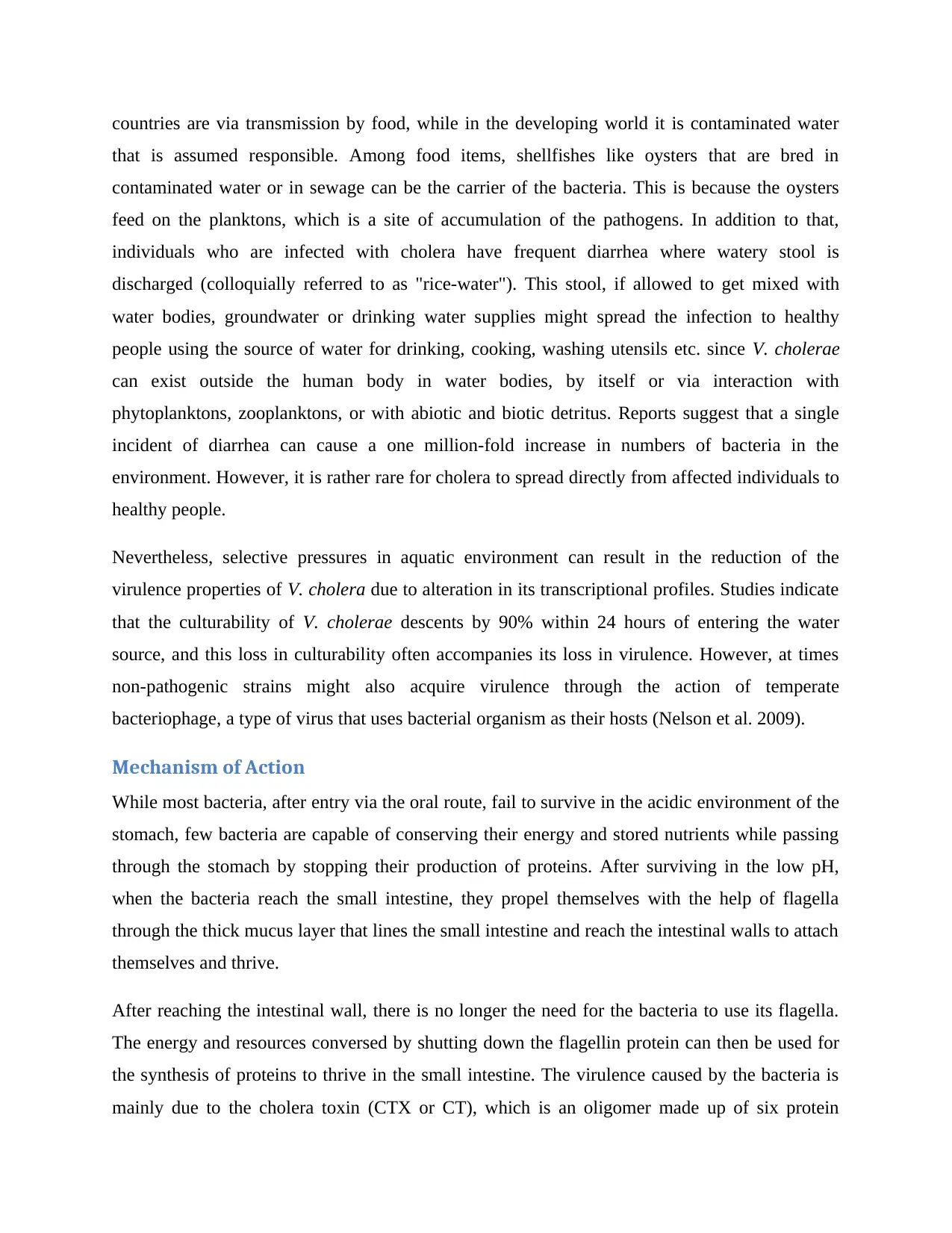
countries are via transmission by food, while in the developing world it is contaminated water
that is assumed responsible. Among food items, shellfishes like oysters that are bred in
contaminated water or in sewage can be the carrier of the bacteria. This is because the oysters
feed on the planktons, which is a site of accumulation of the pathogens. In addition to that,
individuals who are infected with cholera have frequent diarrhea where watery stool is
discharged (colloquially referred to as "rice-water"). This stool, if allowed to get mixed with
water bodies, groundwater or drinking water supplies might spread the infection to healthy
people using the source of water for drinking, cooking, washing utensils etc. since V. cholerae
can exist outside the human body in water bodies, by itself or via interaction with
phytoplanktons, zooplanktons, or with abiotic and biotic detritus. Reports suggest that a single
incident of diarrhea can cause a one million-fold increase in numbers of bacteria in the
environment. However, it is rather rare for cholera to spread directly from affected individuals to
healthy people.
Nevertheless, selective pressures in aquatic environment can result in the reduction of the
virulence properties of V. cholera due to alteration in its transcriptional profiles. Studies indicate
that the culturability of V. cholerae descents by 90% within 24 hours of entering the water
source, and this loss in culturability often accompanies its loss in virulence. However, at times
non-pathogenic strains might also acquire virulence through the action of temperate
bacteriophage, a type of virus that uses bacterial organism as their hosts (Nelson et al. 2009).
Mechanism of Action
While most bacteria, after entry via the oral route, fail to survive in the acidic environment of the
stomach, few bacteria are capable of conserving their energy and stored nutrients while passing
through the stomach by stopping their production of proteins. After surviving in the low pH,
when the bacteria reach the small intestine, they propel themselves with the help of flagella
through the thick mucus layer that lines the small intestine and reach the intestinal walls to attach
themselves and thrive.
After reaching the intestinal wall, there is no longer the need for the bacteria to use its flagella.
The energy and resources conversed by shutting down the flagellin protein can then be used for
the synthesis of proteins to thrive in the small intestine. The virulence caused by the bacteria is
mainly due to the cholera toxin (CTX or CT), which is an oligomer made up of six protein
that is assumed responsible. Among food items, shellfishes like oysters that are bred in
contaminated water or in sewage can be the carrier of the bacteria. This is because the oysters
feed on the planktons, which is a site of accumulation of the pathogens. In addition to that,
individuals who are infected with cholera have frequent diarrhea where watery stool is
discharged (colloquially referred to as "rice-water"). This stool, if allowed to get mixed with
water bodies, groundwater or drinking water supplies might spread the infection to healthy
people using the source of water for drinking, cooking, washing utensils etc. since V. cholerae
can exist outside the human body in water bodies, by itself or via interaction with
phytoplanktons, zooplanktons, or with abiotic and biotic detritus. Reports suggest that a single
incident of diarrhea can cause a one million-fold increase in numbers of bacteria in the
environment. However, it is rather rare for cholera to spread directly from affected individuals to
healthy people.
Nevertheless, selective pressures in aquatic environment can result in the reduction of the
virulence properties of V. cholera due to alteration in its transcriptional profiles. Studies indicate
that the culturability of V. cholerae descents by 90% within 24 hours of entering the water
source, and this loss in culturability often accompanies its loss in virulence. However, at times
non-pathogenic strains might also acquire virulence through the action of temperate
bacteriophage, a type of virus that uses bacterial organism as their hosts (Nelson et al. 2009).
Mechanism of Action
While most bacteria, after entry via the oral route, fail to survive in the acidic environment of the
stomach, few bacteria are capable of conserving their energy and stored nutrients while passing
through the stomach by stopping their production of proteins. After surviving in the low pH,
when the bacteria reach the small intestine, they propel themselves with the help of flagella
through the thick mucus layer that lines the small intestine and reach the intestinal walls to attach
themselves and thrive.
After reaching the intestinal wall, there is no longer the need for the bacteria to use its flagella.
The energy and resources conversed by shutting down the flagellin protein can then be used for
the synthesis of proteins to thrive in the small intestine. The virulence caused by the bacteria is
mainly due to the cholera toxin (CTX or CT), which is an oligomer made up of six protein
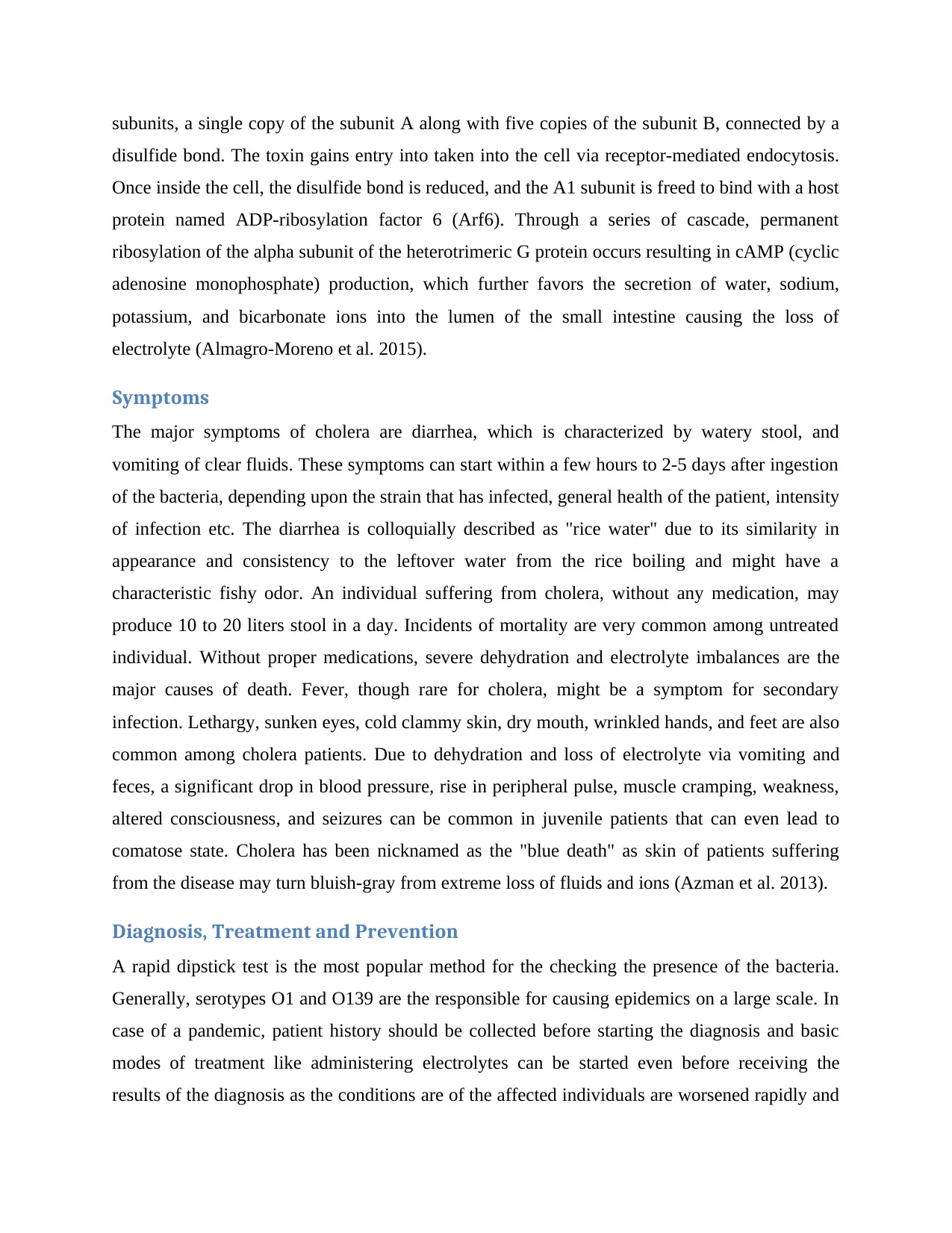
subunits, a single copy of the subunit A along with five copies of the subunit B, connected by a
disulfide bond. The toxin gains entry into taken into the cell via receptor-mediated endocytosis.
Once inside the cell, the disulfide bond is reduced, and the A1 subunit is freed to bind with a host
protein named ADP-ribosylation factor 6 (Arf6). Through a series of cascade, permanent
ribosylation of the alpha subunit of the heterotrimeric G protein occurs resulting in cAMP (cyclic
adenosine monophosphate) production, which further favors the secretion of water, sodium,
potassium, and bicarbonate ions into the lumen of the small intestine causing the loss of
electrolyte (Almagro-Moreno et al. 2015).
Symptoms
The major symptoms of cholera are diarrhea, which is characterized by watery stool, and
vomiting of clear fluids. These symptoms can start within a few hours to 2-5 days after ingestion
of the bacteria, depending upon the strain that has infected, general health of the patient, intensity
of infection etc. The diarrhea is colloquially described as "rice water" due to its similarity in
appearance and consistency to the leftover water from the rice boiling and might have a
characteristic fishy odor. An individual suffering from cholera, without any medication, may
produce 10 to 20 liters stool in a day. Incidents of mortality are very common among untreated
individual. Without proper medications, severe dehydration and electrolyte imbalances are the
major causes of death. Fever, though rare for cholera, might be a symptom for secondary
infection. Lethargy, sunken eyes, cold clammy skin, dry mouth, wrinkled hands, and feet are also
common among cholera patients. Due to dehydration and loss of electrolyte via vomiting and
feces, a significant drop in blood pressure, rise in peripheral pulse, muscle cramping, weakness,
altered consciousness, and seizures can be common in juvenile patients that can even lead to
comatose state. Cholera has been nicknamed as the "blue death" as skin of patients suffering
from the disease may turn bluish-gray from extreme loss of fluids and ions (Azman et al. 2013).
Diagnosis, Treatment and Prevention
A rapid dipstick test is the most popular method for the checking the presence of the bacteria.
Generally, serotypes O1 and O139 are the responsible for causing epidemics on a large scale. In
case of a pandemic, patient history should be collected before starting the diagnosis and basic
modes of treatment like administering electrolytes can be started even before receiving the
results of the diagnosis as the conditions are of the affected individuals are worsened rapidly and
disulfide bond. The toxin gains entry into taken into the cell via receptor-mediated endocytosis.
Once inside the cell, the disulfide bond is reduced, and the A1 subunit is freed to bind with a host
protein named ADP-ribosylation factor 6 (Arf6). Through a series of cascade, permanent
ribosylation of the alpha subunit of the heterotrimeric G protein occurs resulting in cAMP (cyclic
adenosine monophosphate) production, which further favors the secretion of water, sodium,
potassium, and bicarbonate ions into the lumen of the small intestine causing the loss of
electrolyte (Almagro-Moreno et al. 2015).
Symptoms
The major symptoms of cholera are diarrhea, which is characterized by watery stool, and
vomiting of clear fluids. These symptoms can start within a few hours to 2-5 days after ingestion
of the bacteria, depending upon the strain that has infected, general health of the patient, intensity
of infection etc. The diarrhea is colloquially described as "rice water" due to its similarity in
appearance and consistency to the leftover water from the rice boiling and might have a
characteristic fishy odor. An individual suffering from cholera, without any medication, may
produce 10 to 20 liters stool in a day. Incidents of mortality are very common among untreated
individual. Without proper medications, severe dehydration and electrolyte imbalances are the
major causes of death. Fever, though rare for cholera, might be a symptom for secondary
infection. Lethargy, sunken eyes, cold clammy skin, dry mouth, wrinkled hands, and feet are also
common among cholera patients. Due to dehydration and loss of electrolyte via vomiting and
feces, a significant drop in blood pressure, rise in peripheral pulse, muscle cramping, weakness,
altered consciousness, and seizures can be common in juvenile patients that can even lead to
comatose state. Cholera has been nicknamed as the "blue death" as skin of patients suffering
from the disease may turn bluish-gray from extreme loss of fluids and ions (Azman et al. 2013).
Diagnosis, Treatment and Prevention
A rapid dipstick test is the most popular method for the checking the presence of the bacteria.
Generally, serotypes O1 and O139 are the responsible for causing epidemics on a large scale. In
case of a pandemic, patient history should be collected before starting the diagnosis and basic
modes of treatment like administering electrolytes can be started even before receiving the
results of the diagnosis as the conditions are of the affected individuals are worsened rapidly and
⊘ This is a preview!⊘
Do you want full access?
Subscribe today to unlock all pages.

Trusted by 1+ million students worldwide
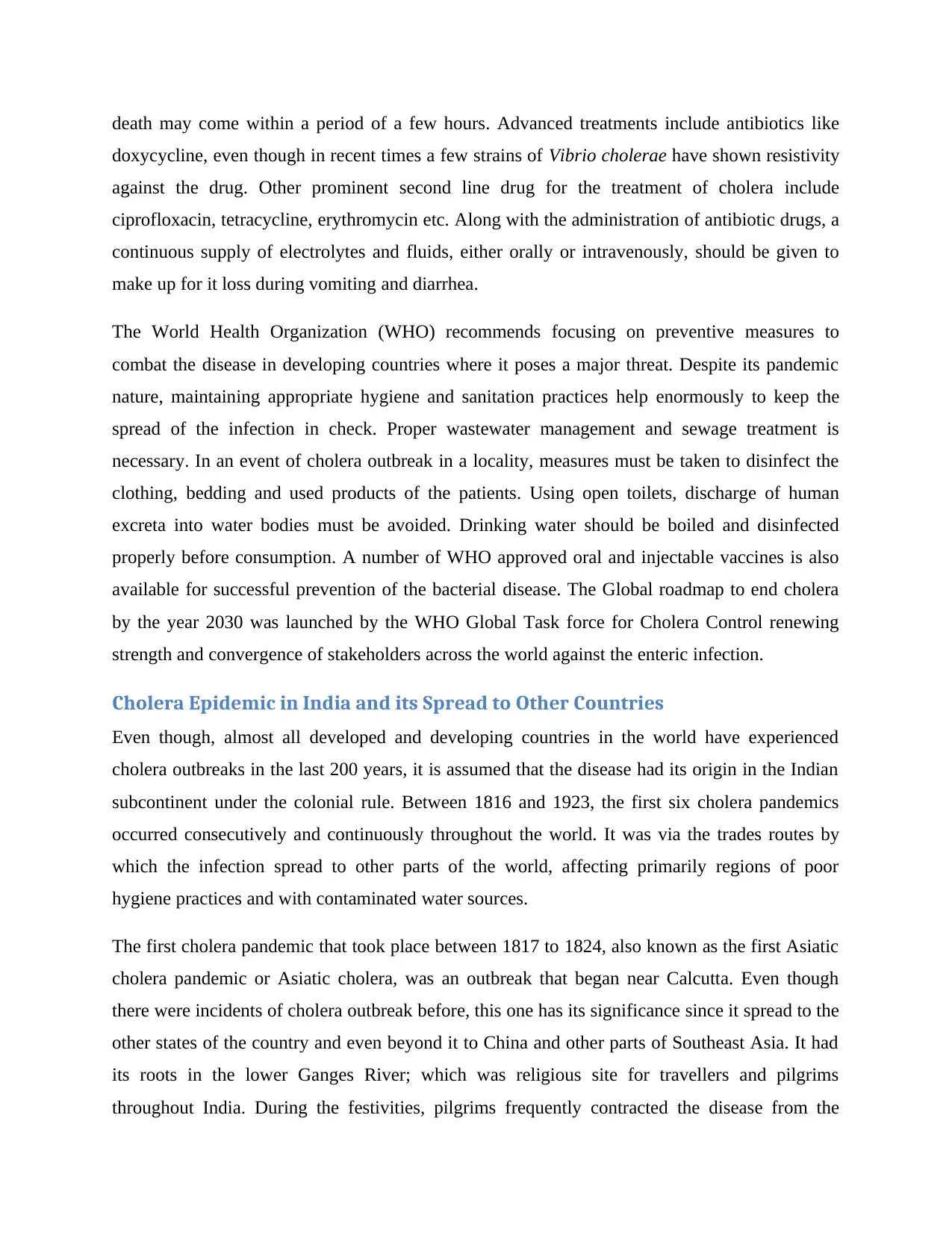
death may come within a period of a few hours. Advanced treatments include antibiotics like
doxycycline, even though in recent times a few strains of Vibrio cholerae have shown resistivity
against the drug. Other prominent second line drug for the treatment of cholera include
ciprofloxacin, tetracycline, erythromycin etc. Along with the administration of antibiotic drugs, a
continuous supply of electrolytes and fluids, either orally or intravenously, should be given to
make up for it loss during vomiting and diarrhea.
The World Health Organization (WHO) recommends focusing on preventive measures to
combat the disease in developing countries where it poses a major threat. Despite its pandemic
nature, maintaining appropriate hygiene and sanitation practices help enormously to keep the
spread of the infection in check. Proper wastewater management and sewage treatment is
necessary. In an event of cholera outbreak in a locality, measures must be taken to disinfect the
clothing, bedding and used products of the patients. Using open toilets, discharge of human
excreta into water bodies must be avoided. Drinking water should be boiled and disinfected
properly before consumption. A number of WHO approved oral and injectable vaccines is also
available for successful prevention of the bacterial disease. The Global roadmap to end cholera
by the year 2030 was launched by the WHO Global Task force for Cholera Control renewing
strength and convergence of stakeholders across the world against the enteric infection.
Cholera Epidemic in India and its Spread to Other Countries
Even though, almost all developed and developing countries in the world have experienced
cholera outbreaks in the last 200 years, it is assumed that the disease had its origin in the Indian
subcontinent under the colonial rule. Between 1816 and 1923, the first six cholera pandemics
occurred consecutively and continuously throughout the world. It was via the trades routes by
which the infection spread to other parts of the world, affecting primarily regions of poor
hygiene practices and with contaminated water sources.
The first cholera pandemic that took place between 1817 to 1824, also known as the first Asiatic
cholera pandemic or Asiatic cholera, was an outbreak that began near Calcutta. Even though
there were incidents of cholera outbreak before, this one has its significance since it spread to the
other states of the country and even beyond it to China and other parts of Southeast Asia. It had
its roots in the lower Ganges River; which was religious site for travellers and pilgrims
throughout India. During the festivities, pilgrims frequently contracted the disease from the
doxycycline, even though in recent times a few strains of Vibrio cholerae have shown resistivity
against the drug. Other prominent second line drug for the treatment of cholera include
ciprofloxacin, tetracycline, erythromycin etc. Along with the administration of antibiotic drugs, a
continuous supply of electrolytes and fluids, either orally or intravenously, should be given to
make up for it loss during vomiting and diarrhea.
The World Health Organization (WHO) recommends focusing on preventive measures to
combat the disease in developing countries where it poses a major threat. Despite its pandemic
nature, maintaining appropriate hygiene and sanitation practices help enormously to keep the
spread of the infection in check. Proper wastewater management and sewage treatment is
necessary. In an event of cholera outbreak in a locality, measures must be taken to disinfect the
clothing, bedding and used products of the patients. Using open toilets, discharge of human
excreta into water bodies must be avoided. Drinking water should be boiled and disinfected
properly before consumption. A number of WHO approved oral and injectable vaccines is also
available for successful prevention of the bacterial disease. The Global roadmap to end cholera
by the year 2030 was launched by the WHO Global Task force for Cholera Control renewing
strength and convergence of stakeholders across the world against the enteric infection.
Cholera Epidemic in India and its Spread to Other Countries
Even though, almost all developed and developing countries in the world have experienced
cholera outbreaks in the last 200 years, it is assumed that the disease had its origin in the Indian
subcontinent under the colonial rule. Between 1816 and 1923, the first six cholera pandemics
occurred consecutively and continuously throughout the world. It was via the trades routes by
which the infection spread to other parts of the world, affecting primarily regions of poor
hygiene practices and with contaminated water sources.
The first cholera pandemic that took place between 1817 to 1824, also known as the first Asiatic
cholera pandemic or Asiatic cholera, was an outbreak that began near Calcutta. Even though
there were incidents of cholera outbreak before, this one has its significance since it spread to the
other states of the country and even beyond it to China and other parts of Southeast Asia. It had
its roots in the lower Ganges River; which was religious site for travellers and pilgrims
throughout India. During the festivities, pilgrims frequently contracted the disease from the
Paraphrase This Document
Need a fresh take? Get an instant paraphrase of this document with our AI Paraphraser
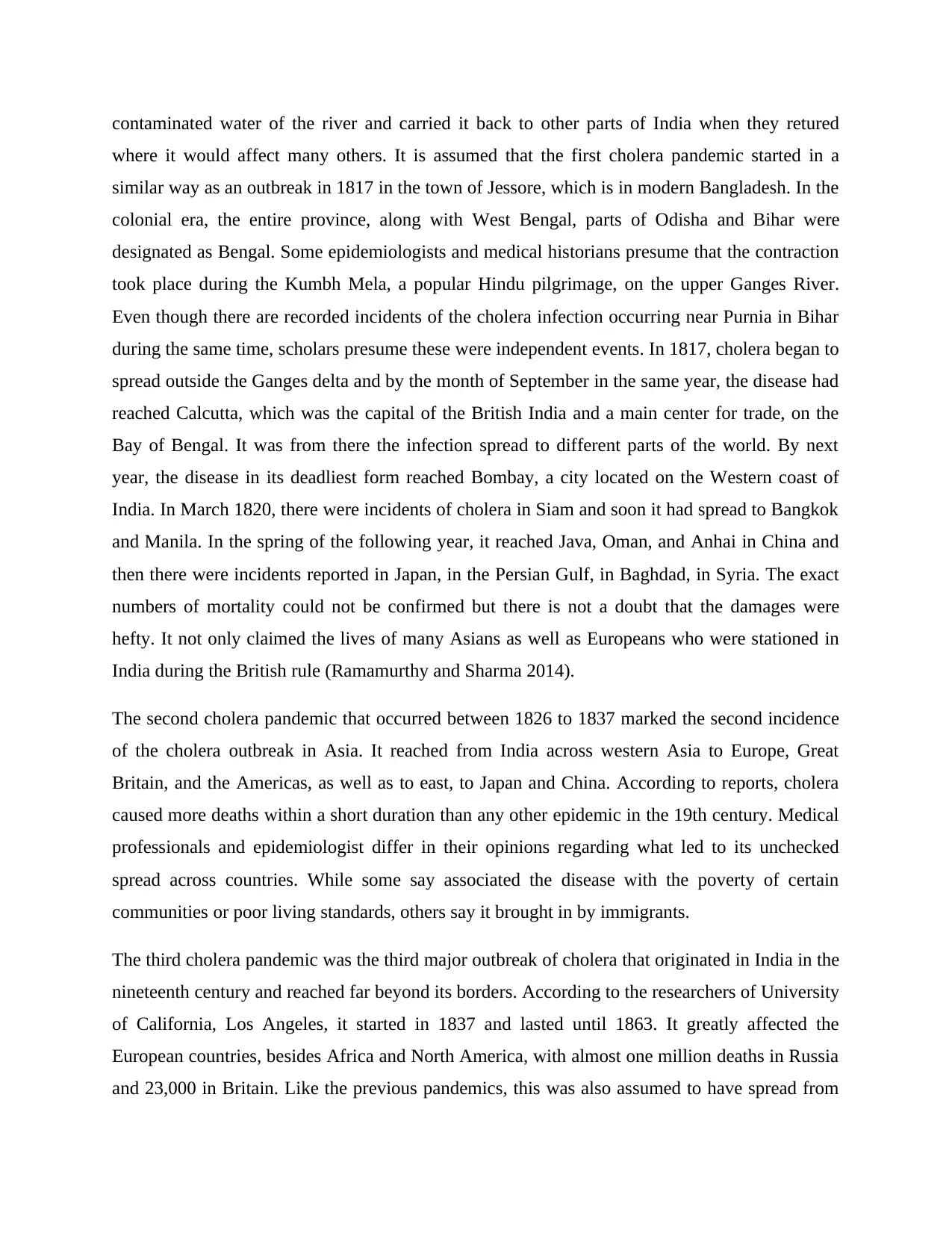
contaminated water of the river and carried it back to other parts of India when they retured
where it would affect many others. It is assumed that the first cholera pandemic started in a
similar way as an outbreak in 1817 in the town of Jessore, which is in modern Bangladesh. In the
colonial era, the entire province, along with West Bengal, parts of Odisha and Bihar were
designated as Bengal. Some epidemiologists and medical historians presume that the contraction
took place during the Kumbh Mela, a popular Hindu pilgrimage, on the upper Ganges River.
Even though there are recorded incidents of the cholera infection occurring near Purnia in Bihar
during the same time, scholars presume these were independent events. In 1817, cholera began to
spread outside the Ganges delta and by the month of September in the same year, the disease had
reached Calcutta, which was the capital of the British India and a main center for trade, on the
Bay of Bengal. It was from there the infection spread to different parts of the world. By next
year, the disease in its deadliest form reached Bombay, a city located on the Western coast of
India. In March 1820, there were incidents of cholera in Siam and soon it had spread to Bangkok
and Manila. In the spring of the following year, it reached Java, Oman, and Anhai in China and
then there were incidents reported in Japan, in the Persian Gulf, in Baghdad, in Syria. The exact
numbers of mortality could not be confirmed but there is not a doubt that the damages were
hefty. It not only claimed the lives of many Asians as well as Europeans who were stationed in
India during the British rule (Ramamurthy and Sharma 2014).
The second cholera pandemic that occurred between 1826 to 1837 marked the second incidence
of the cholera outbreak in Asia. It reached from India across western Asia to Europe, Great
Britain, and the Americas, as well as to east, to Japan and China. According to reports, cholera
caused more deaths within a short duration than any other epidemic in the 19th century. Medical
professionals and epidemiologist differ in their opinions regarding what led to its unchecked
spread across countries. While some say associated the disease with the poverty of certain
communities or poor living standards, others say it brought in by immigrants.
The third cholera pandemic was the third major outbreak of cholera that originated in India in the
nineteenth century and reached far beyond its borders. According to the researchers of University
of California, Los Angeles, it started in 1837 and lasted until 1863. It greatly affected the
European countries, besides Africa and North America, with almost one million deaths in Russia
and 23,000 in Britain. Like the previous pandemics, this was also assumed to have spread from
where it would affect many others. It is assumed that the first cholera pandemic started in a
similar way as an outbreak in 1817 in the town of Jessore, which is in modern Bangladesh. In the
colonial era, the entire province, along with West Bengal, parts of Odisha and Bihar were
designated as Bengal. Some epidemiologists and medical historians presume that the contraction
took place during the Kumbh Mela, a popular Hindu pilgrimage, on the upper Ganges River.
Even though there are recorded incidents of the cholera infection occurring near Purnia in Bihar
during the same time, scholars presume these were independent events. In 1817, cholera began to
spread outside the Ganges delta and by the month of September in the same year, the disease had
reached Calcutta, which was the capital of the British India and a main center for trade, on the
Bay of Bengal. It was from there the infection spread to different parts of the world. By next
year, the disease in its deadliest form reached Bombay, a city located on the Western coast of
India. In March 1820, there were incidents of cholera in Siam and soon it had spread to Bangkok
and Manila. In the spring of the following year, it reached Java, Oman, and Anhai in China and
then there were incidents reported in Japan, in the Persian Gulf, in Baghdad, in Syria. The exact
numbers of mortality could not be confirmed but there is not a doubt that the damages were
hefty. It not only claimed the lives of many Asians as well as Europeans who were stationed in
India during the British rule (Ramamurthy and Sharma 2014).
The second cholera pandemic that occurred between 1826 to 1837 marked the second incidence
of the cholera outbreak in Asia. It reached from India across western Asia to Europe, Great
Britain, and the Americas, as well as to east, to Japan and China. According to reports, cholera
caused more deaths within a short duration than any other epidemic in the 19th century. Medical
professionals and epidemiologist differ in their opinions regarding what led to its unchecked
spread across countries. While some say associated the disease with the poverty of certain
communities or poor living standards, others say it brought in by immigrants.
The third cholera pandemic was the third major outbreak of cholera that originated in India in the
nineteenth century and reached far beyond its borders. According to the researchers of University
of California, Los Angeles, it started in 1837 and lasted until 1863. It greatly affected the
European countries, besides Africa and North America, with almost one million deaths in Russia
and 23,000 in Britain. Like the previous pandemics, this was also assumed to have spread from
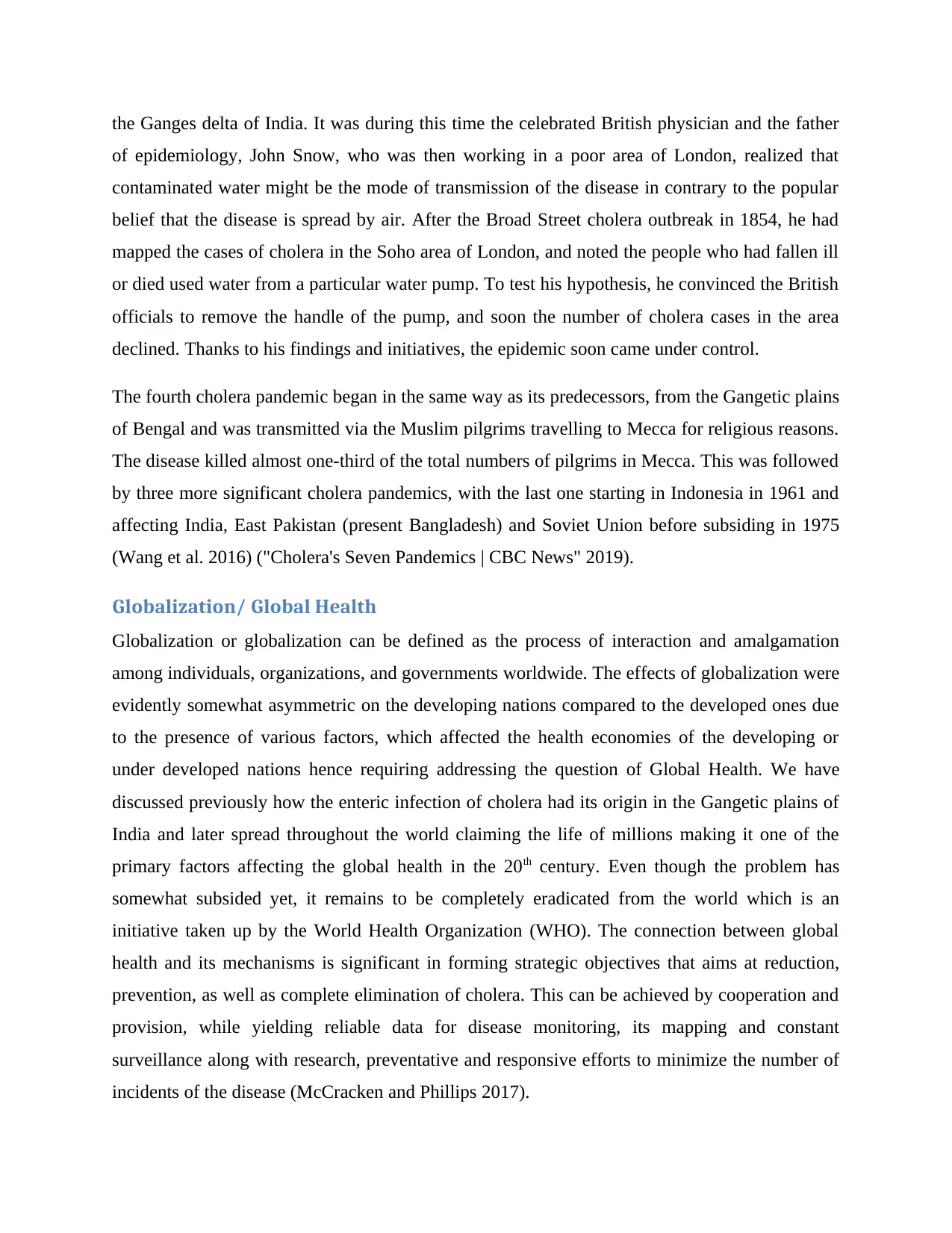
the Ganges delta of India. It was during this time the celebrated British physician and the father
of epidemiology, John Snow, who was then working in a poor area of London, realized that
contaminated water might be the mode of transmission of the disease in contrary to the popular
belief that the disease is spread by air. After the Broad Street cholera outbreak in 1854, he had
mapped the cases of cholera in the Soho area of London, and noted the people who had fallen ill
or died used water from a particular water pump. To test his hypothesis, he convinced the British
officials to remove the handle of the pump, and soon the number of cholera cases in the area
declined. Thanks to his findings and initiatives, the epidemic soon came under control.
The fourth cholera pandemic began in the same way as its predecessors, from the Gangetic plains
of Bengal and was transmitted via the Muslim pilgrims travelling to Mecca for religious reasons.
The disease killed almost one-third of the total numbers of pilgrims in Mecca. This was followed
by three more significant cholera pandemics, with the last one starting in Indonesia in 1961 and
affecting India, East Pakistan (present Bangladesh) and Soviet Union before subsiding in 1975
(Wang et al. 2016) ("Cholera's Seven Pandemics | CBC News" 2019).
Globalization/ Global Health
Globalization or globalization can be defined as the process of interaction and amalgamation
among individuals, organizations, and governments worldwide. The effects of globalization were
evidently somewhat asymmetric on the developing nations compared to the developed ones due
to the presence of various factors, which affected the health economies of the developing or
under developed nations hence requiring addressing the question of Global Health. We have
discussed previously how the enteric infection of cholera had its origin in the Gangetic plains of
India and later spread throughout the world claiming the life of millions making it one of the
primary factors affecting the global health in the 20th century. Even though the problem has
somewhat subsided yet, it remains to be completely eradicated from the world which is an
initiative taken up by the World Health Organization (WHO). The connection between global
health and its mechanisms is significant in forming strategic objectives that aims at reduction,
prevention, as well as complete elimination of cholera. This can be achieved by cooperation and
provision, while yielding reliable data for disease monitoring, its mapping and constant
surveillance along with research, preventative and responsive efforts to minimize the number of
incidents of the disease (McCracken and Phillips 2017).
of epidemiology, John Snow, who was then working in a poor area of London, realized that
contaminated water might be the mode of transmission of the disease in contrary to the popular
belief that the disease is spread by air. After the Broad Street cholera outbreak in 1854, he had
mapped the cases of cholera in the Soho area of London, and noted the people who had fallen ill
or died used water from a particular water pump. To test his hypothesis, he convinced the British
officials to remove the handle of the pump, and soon the number of cholera cases in the area
declined. Thanks to his findings and initiatives, the epidemic soon came under control.
The fourth cholera pandemic began in the same way as its predecessors, from the Gangetic plains
of Bengal and was transmitted via the Muslim pilgrims travelling to Mecca for religious reasons.
The disease killed almost one-third of the total numbers of pilgrims in Mecca. This was followed
by three more significant cholera pandemics, with the last one starting in Indonesia in 1961 and
affecting India, East Pakistan (present Bangladesh) and Soviet Union before subsiding in 1975
(Wang et al. 2016) ("Cholera's Seven Pandemics | CBC News" 2019).
Globalization/ Global Health
Globalization or globalization can be defined as the process of interaction and amalgamation
among individuals, organizations, and governments worldwide. The effects of globalization were
evidently somewhat asymmetric on the developing nations compared to the developed ones due
to the presence of various factors, which affected the health economies of the developing or
under developed nations hence requiring addressing the question of Global Health. We have
discussed previously how the enteric infection of cholera had its origin in the Gangetic plains of
India and later spread throughout the world claiming the life of millions making it one of the
primary factors affecting the global health in the 20th century. Even though the problem has
somewhat subsided yet, it remains to be completely eradicated from the world which is an
initiative taken up by the World Health Organization (WHO). The connection between global
health and its mechanisms is significant in forming strategic objectives that aims at reduction,
prevention, as well as complete elimination of cholera. This can be achieved by cooperation and
provision, while yielding reliable data for disease monitoring, its mapping and constant
surveillance along with research, preventative and responsive efforts to minimize the number of
incidents of the disease (McCracken and Phillips 2017).
⊘ This is a preview!⊘
Do you want full access?
Subscribe today to unlock all pages.

Trusted by 1+ million students worldwide
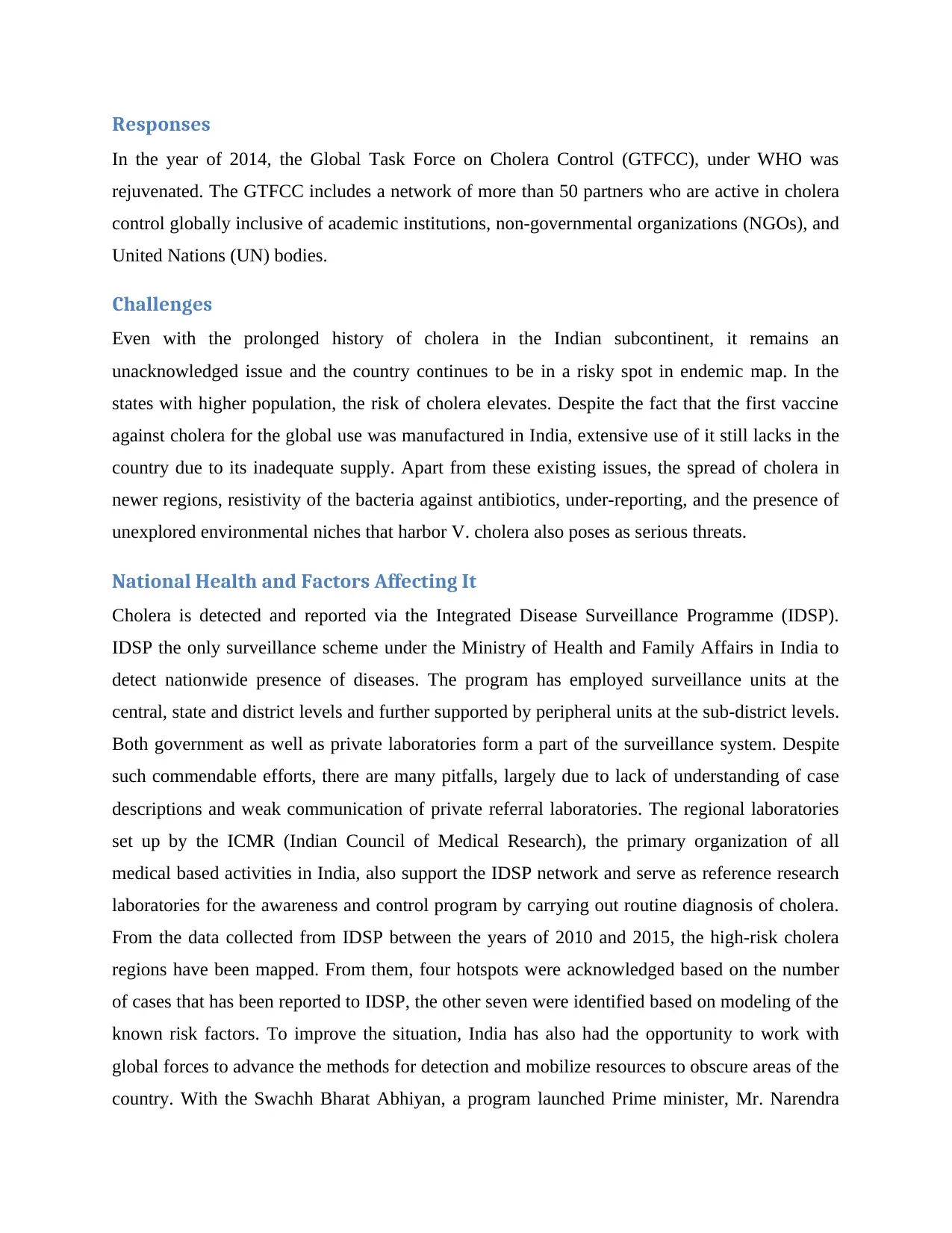
Responses
In the year of 2014, the Global Task Force on Cholera Control (GTFCC), under WHO was
rejuvenated. The GTFCC includes a network of more than 50 partners who are active in cholera
control globally inclusive of academic institutions, non-governmental organizations (NGOs), and
United Nations (UN) bodies.
Challenges
Even with the prolonged history of cholera in the Indian subcontinent, it remains an
unacknowledged issue and the country continues to be in a risky spot in endemic map. In the
states with higher population, the risk of cholera elevates. Despite the fact that the first vaccine
against cholera for the global use was manufactured in India, extensive use of it still lacks in the
country due to its inadequate supply. Apart from these existing issues, the spread of cholera in
newer regions, resistivity of the bacteria against antibiotics, under-reporting, and the presence of
unexplored environmental niches that harbor V. cholera also poses as serious threats.
National Health and Factors Affecting It
Cholera is detected and reported via the Integrated Disease Surveillance Programme (IDSP).
IDSP the only surveillance scheme under the Ministry of Health and Family Affairs in India to
detect nationwide presence of diseases. The program has employed surveillance units at the
central, state and district levels and further supported by peripheral units at the sub-district levels.
Both government as well as private laboratories form a part of the surveillance system. Despite
such commendable efforts, there are many pitfalls, largely due to lack of understanding of case
descriptions and weak communication of private referral laboratories. The regional laboratories
set up by the ICMR (Indian Council of Medical Research), the primary organization of all
medical based activities in India, also support the IDSP network and serve as reference research
laboratories for the awareness and control program by carrying out routine diagnosis of cholera.
From the data collected from IDSP between the years of 2010 and 2015, the high-risk cholera
regions have been mapped. From them, four hotspots were acknowledged based on the number
of cases that has been reported to IDSP, the other seven were identified based on modeling of the
known risk factors. To improve the situation, India has also had the opportunity to work with
global forces to advance the methods for detection and mobilize resources to obscure areas of the
country. With the Swachh Bharat Abhiyan, a program launched Prime minister, Mr. Narendra
In the year of 2014, the Global Task Force on Cholera Control (GTFCC), under WHO was
rejuvenated. The GTFCC includes a network of more than 50 partners who are active in cholera
control globally inclusive of academic institutions, non-governmental organizations (NGOs), and
United Nations (UN) bodies.
Challenges
Even with the prolonged history of cholera in the Indian subcontinent, it remains an
unacknowledged issue and the country continues to be in a risky spot in endemic map. In the
states with higher population, the risk of cholera elevates. Despite the fact that the first vaccine
against cholera for the global use was manufactured in India, extensive use of it still lacks in the
country due to its inadequate supply. Apart from these existing issues, the spread of cholera in
newer regions, resistivity of the bacteria against antibiotics, under-reporting, and the presence of
unexplored environmental niches that harbor V. cholera also poses as serious threats.
National Health and Factors Affecting It
Cholera is detected and reported via the Integrated Disease Surveillance Programme (IDSP).
IDSP the only surveillance scheme under the Ministry of Health and Family Affairs in India to
detect nationwide presence of diseases. The program has employed surveillance units at the
central, state and district levels and further supported by peripheral units at the sub-district levels.
Both government as well as private laboratories form a part of the surveillance system. Despite
such commendable efforts, there are many pitfalls, largely due to lack of understanding of case
descriptions and weak communication of private referral laboratories. The regional laboratories
set up by the ICMR (Indian Council of Medical Research), the primary organization of all
medical based activities in India, also support the IDSP network and serve as reference research
laboratories for the awareness and control program by carrying out routine diagnosis of cholera.
From the data collected from IDSP between the years of 2010 and 2015, the high-risk cholera
regions have been mapped. From them, four hotspots were acknowledged based on the number
of cases that has been reported to IDSP, the other seven were identified based on modeling of the
known risk factors. To improve the situation, India has also had the opportunity to work with
global forces to advance the methods for detection and mobilize resources to obscure areas of the
country. With the Swachh Bharat Abhiyan, a program launched Prime minister, Mr. Narendra
Paraphrase This Document
Need a fresh take? Get an instant paraphrase of this document with our AI Paraphraser
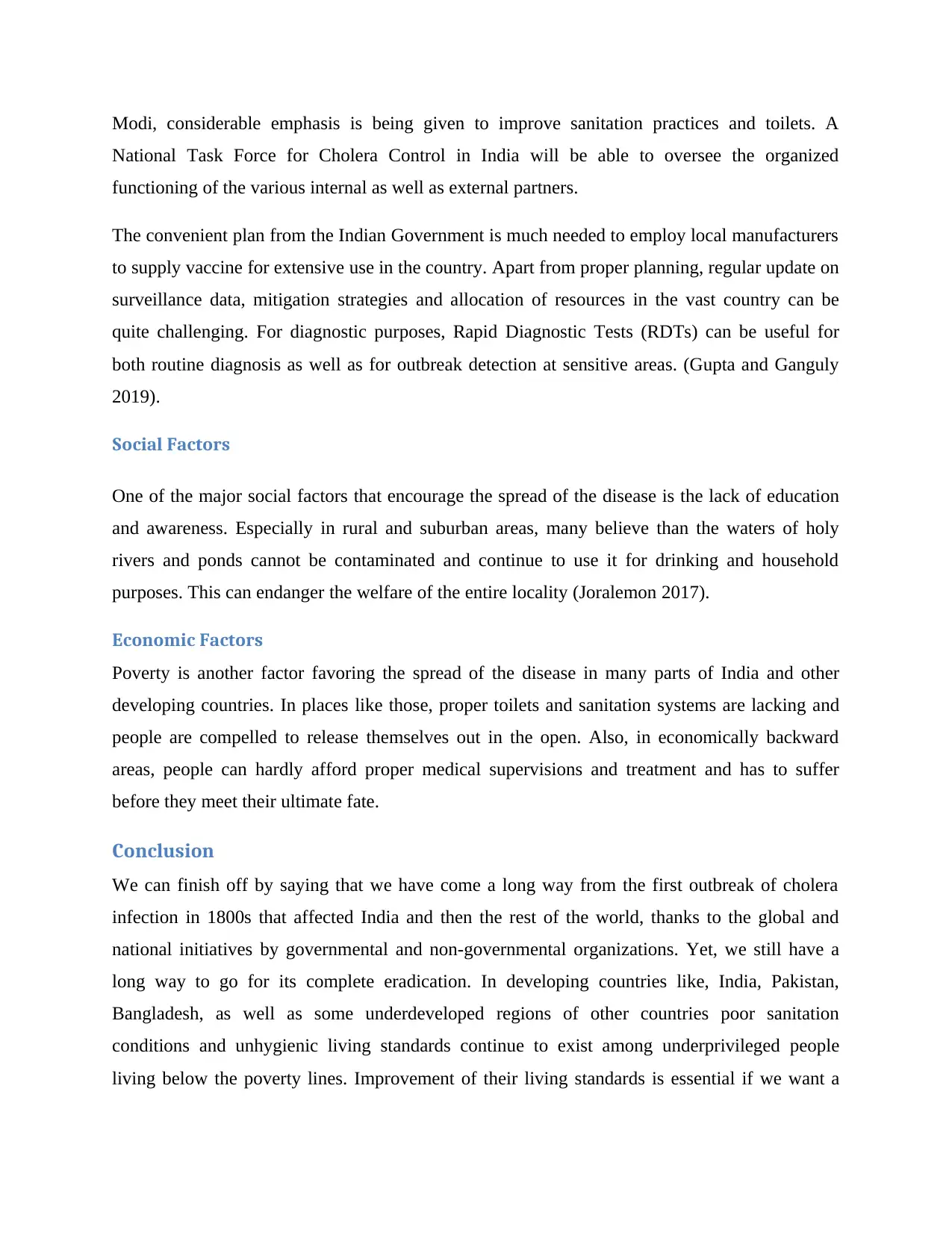
Modi, considerable emphasis is being given to improve sanitation practices and toilets. A
National Task Force for Cholera Control in India will be able to oversee the organized
functioning of the various internal as well as external partners.
The convenient plan from the Indian Government is much needed to employ local manufacturers
to supply vaccine for extensive use in the country. Apart from proper planning, regular update on
surveillance data, mitigation strategies and allocation of resources in the vast country can be
quite challenging. For diagnostic purposes, Rapid Diagnostic Tests (RDTs) can be useful for
both routine diagnosis as well as for outbreak detection at sensitive areas. (Gupta and Ganguly
2019).
Social Factors
One of the major social factors that encourage the spread of the disease is the lack of education
and awareness. Especially in rural and suburban areas, many believe than the waters of holy
rivers and ponds cannot be contaminated and continue to use it for drinking and household
purposes. This can endanger the welfare of the entire locality (Joralemon 2017).
Economic Factors
Poverty is another factor favoring the spread of the disease in many parts of India and other
developing countries. In places like those, proper toilets and sanitation systems are lacking and
people are compelled to release themselves out in the open. Also, in economically backward
areas, people can hardly afford proper medical supervisions and treatment and has to suffer
before they meet their ultimate fate.
Conclusion
We can finish off by saying that we have come a long way from the first outbreak of cholera
infection in 1800s that affected India and then the rest of the world, thanks to the global and
national initiatives by governmental and non-governmental organizations. Yet, we still have a
long way to go for its complete eradication. In developing countries like, India, Pakistan,
Bangladesh, as well as some underdeveloped regions of other countries poor sanitation
conditions and unhygienic living standards continue to exist among underprivileged people
living below the poverty lines. Improvement of their living standards is essential if we want a
National Task Force for Cholera Control in India will be able to oversee the organized
functioning of the various internal as well as external partners.
The convenient plan from the Indian Government is much needed to employ local manufacturers
to supply vaccine for extensive use in the country. Apart from proper planning, regular update on
surveillance data, mitigation strategies and allocation of resources in the vast country can be
quite challenging. For diagnostic purposes, Rapid Diagnostic Tests (RDTs) can be useful for
both routine diagnosis as well as for outbreak detection at sensitive areas. (Gupta and Ganguly
2019).
Social Factors
One of the major social factors that encourage the spread of the disease is the lack of education
and awareness. Especially in rural and suburban areas, many believe than the waters of holy
rivers and ponds cannot be contaminated and continue to use it for drinking and household
purposes. This can endanger the welfare of the entire locality (Joralemon 2017).
Economic Factors
Poverty is another factor favoring the spread of the disease in many parts of India and other
developing countries. In places like those, proper toilets and sanitation systems are lacking and
people are compelled to release themselves out in the open. Also, in economically backward
areas, people can hardly afford proper medical supervisions and treatment and has to suffer
before they meet their ultimate fate.
Conclusion
We can finish off by saying that we have come a long way from the first outbreak of cholera
infection in 1800s that affected India and then the rest of the world, thanks to the global and
national initiatives by governmental and non-governmental organizations. Yet, we still have a
long way to go for its complete eradication. In developing countries like, India, Pakistan,
Bangladesh, as well as some underdeveloped regions of other countries poor sanitation
conditions and unhygienic living standards continue to exist among underprivileged people
living below the poverty lines. Improvement of their living standards is essential if we want a
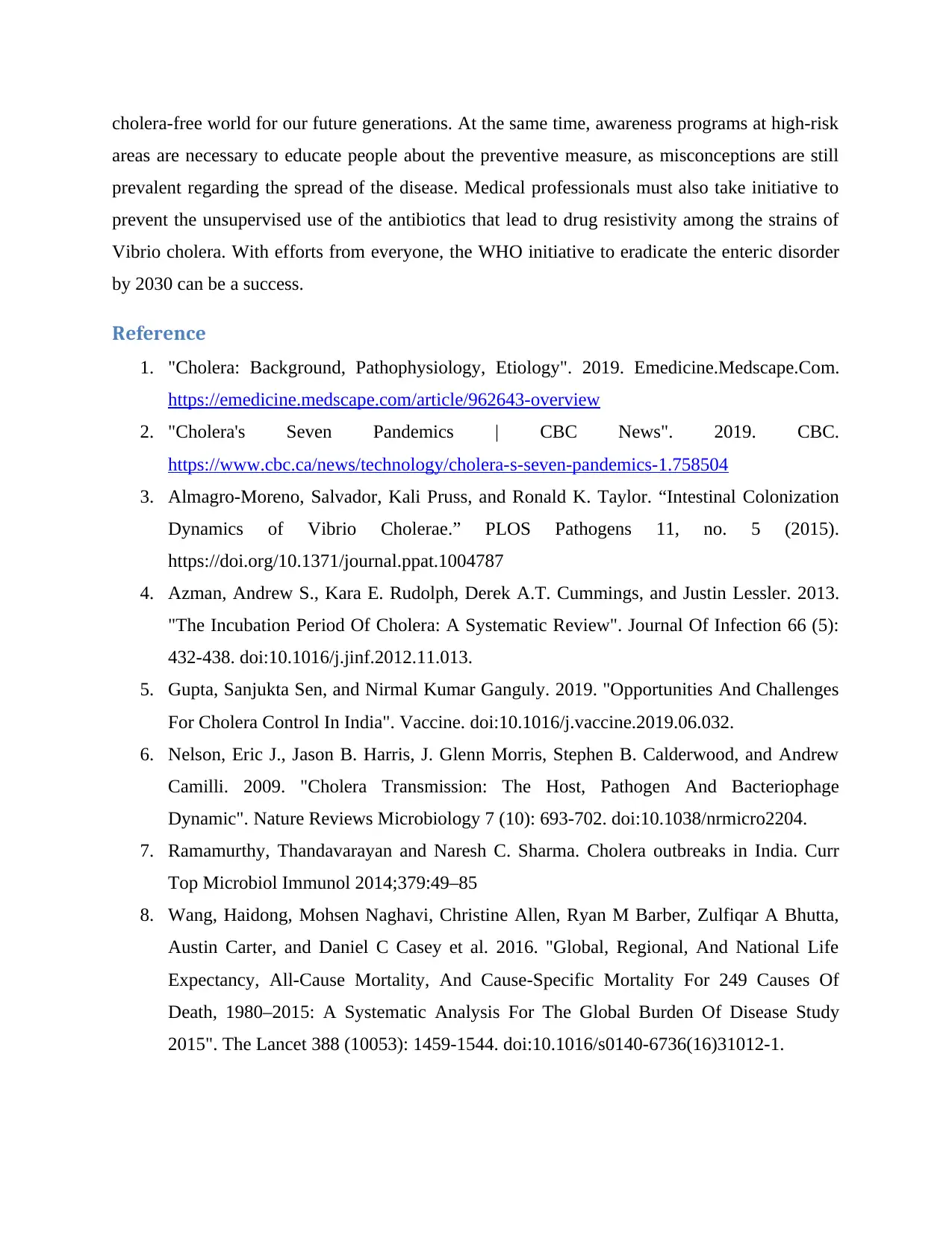
cholera-free world for our future generations. At the same time, awareness programs at high-risk
areas are necessary to educate people about the preventive measure, as misconceptions are still
prevalent regarding the spread of the disease. Medical professionals must also take initiative to
prevent the unsupervised use of the antibiotics that lead to drug resistivity among the strains of
Vibrio cholera. With efforts from everyone, the WHO initiative to eradicate the enteric disorder
by 2030 can be a success.
Reference
1. "Cholera: Background, Pathophysiology, Etiology". 2019. Emedicine.Medscape.Com.
https://emedicine.medscape.com/article/962643-overview
2. "Cholera's Seven Pandemics | CBC News". 2019. CBC.
https://www.cbc.ca/news/technology/cholera-s-seven-pandemics-1.758504
3. Almagro-Moreno, Salvador, Kali Pruss, and Ronald K. Taylor. “Intestinal Colonization
Dynamics of Vibrio Cholerae.” PLOS Pathogens 11, no. 5 (2015).
https://doi.org/10.1371/journal.ppat.1004787
4. Azman, Andrew S., Kara E. Rudolph, Derek A.T. Cummings, and Justin Lessler. 2013.
"The Incubation Period Of Cholera: A Systematic Review". Journal Of Infection 66 (5):
432-438. doi:10.1016/j.jinf.2012.11.013.
5. Gupta, Sanjukta Sen, and Nirmal Kumar Ganguly. 2019. "Opportunities And Challenges
For Cholera Control In India". Vaccine. doi:10.1016/j.vaccine.2019.06.032.
6. Nelson, Eric J., Jason B. Harris, J. Glenn Morris, Stephen B. Calderwood, and Andrew
Camilli. 2009. "Cholera Transmission: The Host, Pathogen And Bacteriophage
Dynamic". Nature Reviews Microbiology 7 (10): 693-702. doi:10.1038/nrmicro2204.
7. Ramamurthy, Thandavarayan and Naresh C. Sharma. Cholera outbreaks in India. Curr
Top Microbiol Immunol 2014;379:49–85
8. Wang, Haidong, Mohsen Naghavi, Christine Allen, Ryan M Barber, Zulfiqar A Bhutta,
Austin Carter, and Daniel C Casey et al. 2016. "Global, Regional, And National Life
Expectancy, All-Cause Mortality, And Cause-Specific Mortality For 249 Causes Of
Death, 1980–2015: A Systematic Analysis For The Global Burden Of Disease Study
2015". The Lancet 388 (10053): 1459-1544. doi:10.1016/s0140-6736(16)31012-1.
areas are necessary to educate people about the preventive measure, as misconceptions are still
prevalent regarding the spread of the disease. Medical professionals must also take initiative to
prevent the unsupervised use of the antibiotics that lead to drug resistivity among the strains of
Vibrio cholera. With efforts from everyone, the WHO initiative to eradicate the enteric disorder
by 2030 can be a success.
Reference
1. "Cholera: Background, Pathophysiology, Etiology". 2019. Emedicine.Medscape.Com.
https://emedicine.medscape.com/article/962643-overview
2. "Cholera's Seven Pandemics | CBC News". 2019. CBC.
https://www.cbc.ca/news/technology/cholera-s-seven-pandemics-1.758504
3. Almagro-Moreno, Salvador, Kali Pruss, and Ronald K. Taylor. “Intestinal Colonization
Dynamics of Vibrio Cholerae.” PLOS Pathogens 11, no. 5 (2015).
https://doi.org/10.1371/journal.ppat.1004787
4. Azman, Andrew S., Kara E. Rudolph, Derek A.T. Cummings, and Justin Lessler. 2013.
"The Incubation Period Of Cholera: A Systematic Review". Journal Of Infection 66 (5):
432-438. doi:10.1016/j.jinf.2012.11.013.
5. Gupta, Sanjukta Sen, and Nirmal Kumar Ganguly. 2019. "Opportunities And Challenges
For Cholera Control In India". Vaccine. doi:10.1016/j.vaccine.2019.06.032.
6. Nelson, Eric J., Jason B. Harris, J. Glenn Morris, Stephen B. Calderwood, and Andrew
Camilli. 2009. "Cholera Transmission: The Host, Pathogen And Bacteriophage
Dynamic". Nature Reviews Microbiology 7 (10): 693-702. doi:10.1038/nrmicro2204.
7. Ramamurthy, Thandavarayan and Naresh C. Sharma. Cholera outbreaks in India. Curr
Top Microbiol Immunol 2014;379:49–85
8. Wang, Haidong, Mohsen Naghavi, Christine Allen, Ryan M Barber, Zulfiqar A Bhutta,
Austin Carter, and Daniel C Casey et al. 2016. "Global, Regional, And National Life
Expectancy, All-Cause Mortality, And Cause-Specific Mortality For 249 Causes Of
Death, 1980–2015: A Systematic Analysis For The Global Burden Of Disease Study
2015". The Lancet 388 (10053): 1459-1544. doi:10.1016/s0140-6736(16)31012-1.
⊘ This is a preview!⊘
Do you want full access?
Subscribe today to unlock all pages.

Trusted by 1+ million students worldwide
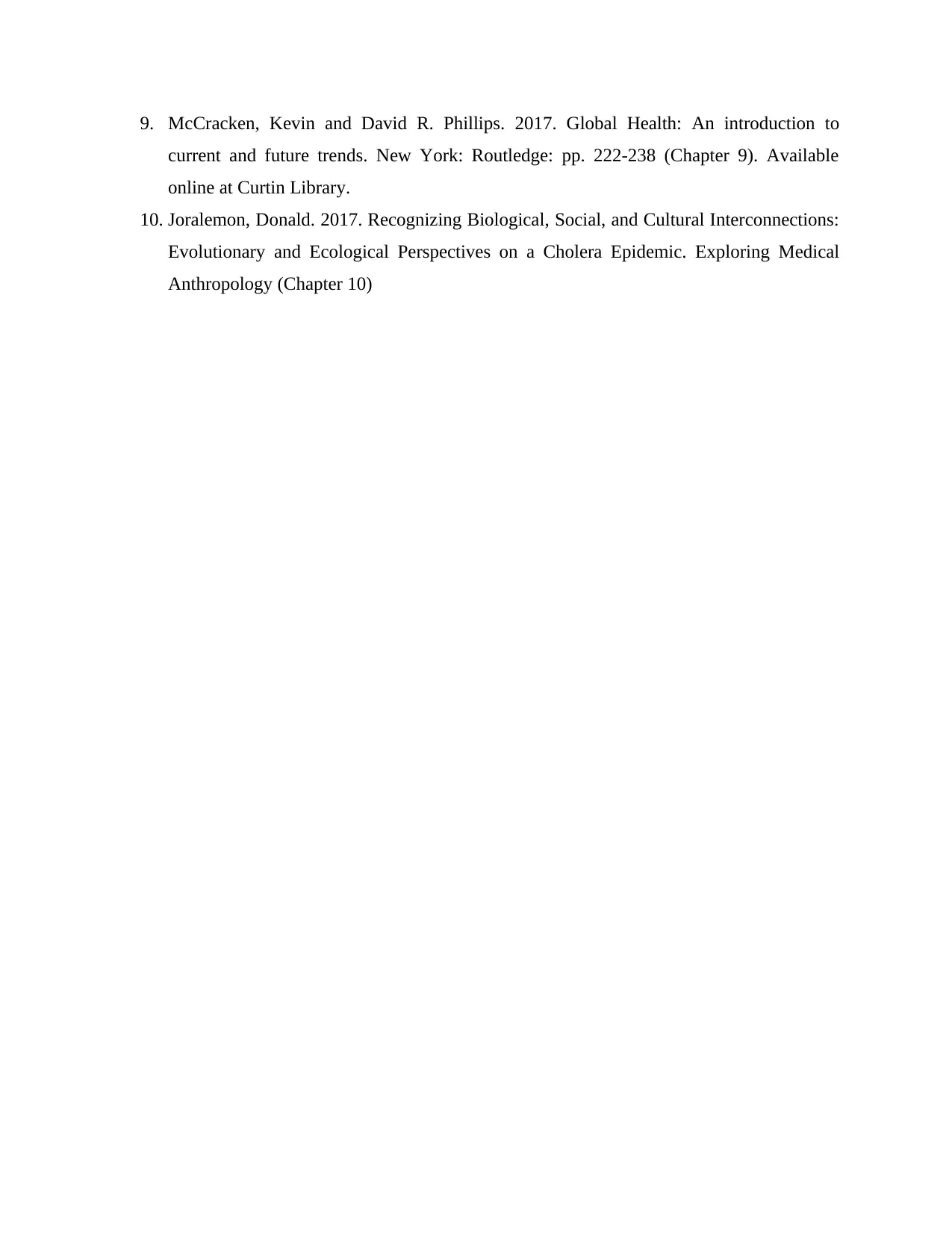
9. McCracken, Kevin and David R. Phillips. 2017. Global Health: An introduction to
current and future trends. New York: Routledge: pp. 222-238 (Chapter 9). Available
online at Curtin Library.
10. Joralemon, Donald. 2017. Recognizing Biological, Social, and Cultural Interconnections:
Evolutionary and Ecological Perspectives on a Cholera Epidemic. Exploring Medical
Anthropology (Chapter 10)
current and future trends. New York: Routledge: pp. 222-238 (Chapter 9). Available
online at Curtin Library.
10. Joralemon, Donald. 2017. Recognizing Biological, Social, and Cultural Interconnections:
Evolutionary and Ecological Perspectives on a Cholera Epidemic. Exploring Medical
Anthropology (Chapter 10)
1 out of 10
Related Documents
Your All-in-One AI-Powered Toolkit for Academic Success.
+13062052269
info@desklib.com
Available 24*7 on WhatsApp / Email
![[object Object]](/_next/static/media/star-bottom.7253800d.svg)
Unlock your academic potential
Copyright © 2020–2025 A2Z Services. All Rights Reserved. Developed and managed by ZUCOL.





